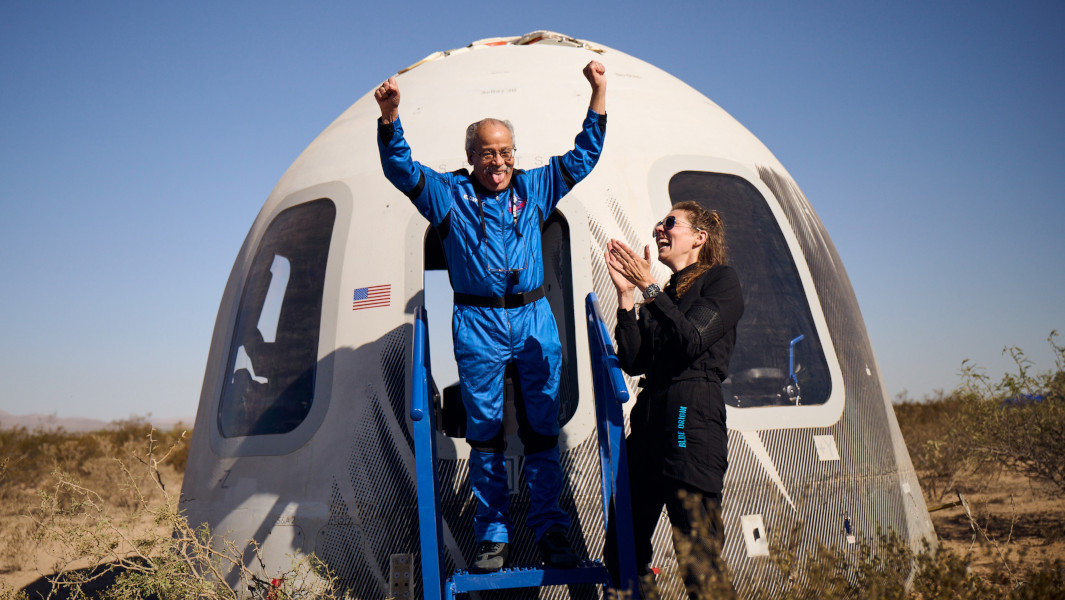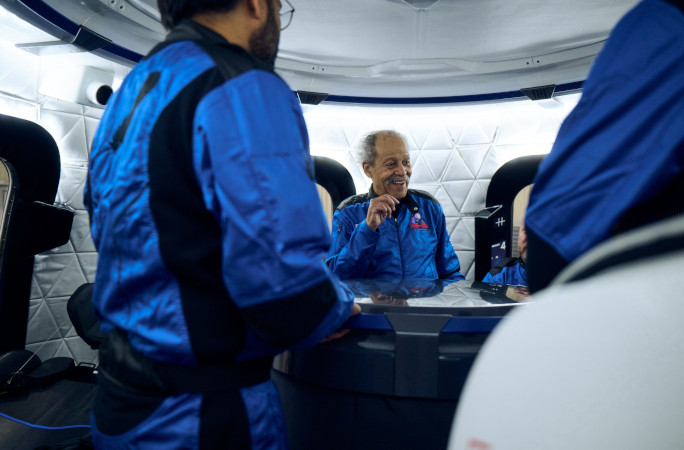First Black astronaut candidate Ed Dwight becomes oldest man to fly to space at age 90

When Ed Dwight (USA) was four years old, he built a toy aeroplane out of orange crates in the backyard of his home in Kansas City, Kansas.
Nearly 28 years later, upon the personal recommendation of President John F. Kennedy, he became the first Black American to enter the Air Force training program from which NASA selected astronauts.
But it wasn’t until 19 May 2024 – over six decades after he was first recruited as an astronaut – that the accomplished nonagenarian finally got to space.
As part of Blue Origin’s NS-25 mission, Ed Dwight became the oldest man to fly in zero gravity last year at the age of 90 years and 253 days old. He took off from Van Horn, Texas, USA on a New Shepard rocket, which spent about 10 minutes in orbit after reaching a maximum altitude of 65.7 miles (105 km) and returning to Earth.
“I thought I didn't need this in my life,” Ed said to the BBC after touchdown, “but I lied. I really did need it.”
The senior’s trip to the stars was a long time coming – while growing up in a racially segregated town not far from an airbase, the first time he saw a Black pilot was on the front page of a newspaper he was delivering as a paperboy.
“And so that encouraged me,” he said to NPR. “When I saw that guy standing on the front of that plane, I wasn't concerned about him getting shot down; I was more rapt about the idea of him flying a jet.”
In 1953, Ed joined the US Air Force and completed pilot training, while grabbing an Aeronautical Engineering degree from Arizona State University on the way. But his life changed in 1961 when he received a letter from the Pentagon – signed by President John F. Kennedy – asking him if he'd like to become the first Black astronaut.
“And I thought, ‘Hell no.’ Why in the world would I ruin a wonderful career to go and hang out with these guys who didn't know what the hell they were doing at the beginning?” said Ed to PBS. “NASA was only two-years-old and they were talking about putting a Black guy in space?”
Nevertheless, Ed was supremely qualified, and he ended up accepting the offer. He went through astronaut training as part of the military's Manned Orbiting Laboratory programme, and was placed eighth as a contender for NASA's Astronaut Group 3 in October 1963. Along the way, he faced intense public scrutiny and racism as he was announced by the Kennedy administration as the first Black astronaut.
“I’d advise everybody to go through what I went through, and then they’d have a different view of this country and how sacred it is,” Ed said. “We’re on this little ball flying around the galaxy.”
Unfortunately, his hopes were dashed, however, when the President was assassinated just a month later – and he lost all the government support that once nearly elevated him to the stars.
“The day the president got killed, my life changed," he said. “22 November 1963 was literally the end of our project.”
Despite the fact that the US had a qualified Black astronaut candidate in the 1960s, it took nearly 20 years for NASA to send someone to space who was not white, male, or from a military background. Guion “Guy” Bluford – also an aerospace engineer and USAF pilot – first took to the skies on an Orbiter Challenger, and officially took the title as the first African-American astronaut to travel into space (male) in 1983.
Yet even though he missed his chance at space flight in the 20th century, Ed was not bogged down by disappointment – instead, he threw himself into a successful career as a sculptor.
In the mid-1970s, he received a Master of Fine Arts, and began working on pieces that depicted Black history: from slavery to emancipation, the American West to the evolution of Jazz, and various other political and cultural figures.
His work was displayed all over the US – from the Smithsonian to churches and HBCUs – and it’s entirely possible that Ed’s aerospace legacy would have been overshadowed by his artistic achievements.
That is, until Space for Humanity offered to finally send him to space.

Image credit: Blue Origin
“He was in our sights,” said Antonio Peronace, Space for Humanity's Executive Director, to the BBC. The non-profit works to expand access to space travel for everyone, and paid for Ed’s flight to achieve his long-awaited goal.
“Occasionally we select an individual that doesn't go through the application process – like Ed Dwight – where we know that their story has been and or will be very impactful to individuals,” he continued.
We knew we were helping to make this chapter of a space dream come true, because we want to reignite the idea of breaking down barriers at that elevation. Not to give up, to show bravery in the face of adversity, and Ed Dwight embodies all that. - Antonio Peronace, Space for Humanity's Executive Director
And on 19 May – at the age of 90 – Ed finally zipped up his spacesuit, and began to float amongst the stars in zero gravity.
“Out the window, I could see the Earth,” he said to the AARP. “Everything looked ordered and neat and wonderful and beautiful. There was no separation between countries or states. And you ask yourself: ‘As wonderful as it all is, why can’t the people who live on it get along? Why don’t they want to take care of such a beautiful place?’”
We just completed our seventh human spaceflight and the 25th flight for the New Shepard program. Our #NS25 astronaut crew included: Mason Angel, Sylvain Chiron, Ed Dwight, Ken Hess, Carol Schaller, and Gopi Thotakura. Thank you, astronauts! Learn more: https://t.co/4a0UXRy6p6 pic.twitter.com/kzL5GIQSql
— Blue Origin (@blueorigin) May 19, 2024
Congratulations, again, Ed on achieving your long-awaited dream – you are Officially Amazing!
Header image: Blue Origin


